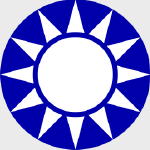Hobby Master HG4902 Republic of China (Taiwanese) M5A1 Stuart Light Tank - 3rd Company, 1st Battalion, 3rd Armored Regiment, China, October 1949 (1:72 Scale)
"We become what we do."
- Chinese President Chiang Kai-Shek
 The M5 Stuart light tank made its debut in the invasion of Casablanca in French North Africa. By 1943, and at the time of the invasion of Sicily, the upgraded M5A1 was becoming the standard light tank of the American armored divisions. Because of its limited firepower, the M5A1 eventually took on reconnaissance and escort duties in Italy and, after the invasion of Normandy, throughout Europe. In the Pacific theater, the M5A1 made its debut at Roi-Namur in February 1944 and on Saipan later that year. The M5A1 was quite effective against most Japanese armor, even the Japanese Type 97 Chi-Ha medium tank typically used in the Pacific theater. The 37mm main gun, although obsolete in Europe, was found to be effective against lightly skinned Japanese targets. Consequently, many other vehicles carrying the 37mm gun, such as the M8 armored car and M3 anti-tank gun, were retained and used in the Pacific theater.
The M5 Stuart light tank made its debut in the invasion of Casablanca in French North Africa. By 1943, and at the time of the invasion of Sicily, the upgraded M5A1 was becoming the standard light tank of the American armored divisions. Because of its limited firepower, the M5A1 eventually took on reconnaissance and escort duties in Italy and, after the invasion of Normandy, throughout Europe. In the Pacific theater, the M5A1 made its debut at Roi-Namur in February 1944 and on Saipan later that year. The M5A1 was quite effective against most Japanese armor, even the Japanese Type 97 Chi-Ha medium tank typically used in the Pacific theater. The 37mm main gun, although obsolete in Europe, was found to be effective against lightly skinned Japanese targets. Consequently, many other vehicles carrying the 37mm gun, such as the M8 armored car and M3 anti-tank gun, were retained and used in the Pacific theater.
Pictured here is a 1:72 scale replica of a Republic of China M5A1 Stuart light tank that was attached to the Kuomintang's 3rd Company, 1st Battalion, 3rd Armored Regiment, involved in the Chinese Civil War during October 1949.
Sold Out!
Dimensions:
Length: 2-1/2-inches
Width: 1-1/4-inches
Release Date: September 2011
Historical Account: "Splitsville" - The Chinese Civil War was a civil war fought between the Kuomintang (KMT or Chinese Nationalist Party), the governing party of the Republic of China and the Communist Party of China (CPC), for the control of China which eventually led to China's division into two Chinas, Republic of China (now commonly known as Taiwan) and People's Republic of China (Mainland China). The war began in April 1927, amidst the Northern Expedition.
The war represented an ideological split between the Nationalist KMT, and the Communist CPC. In mainland China today, the last three years of the war (1947 - 1949) is more commonly known as the War of Liberation.
The civil war continued intermittently until the Second Sino-Japanese War interrupted it, resulting in the two parties forming a Second United Front. Japan's campaign was defeated in 1945, marking the end of World War II, and China's full-scale civil war resumed in 1946. After a further four years, 1950 saw a cessation of major military hostilities with the newly founded People's Republic of China controlling mainland China (including Hainan Island), and the Republic of China's jurisdiction being restricted to Taiwan, Penghu, Kinmen, Matsu and several outlying islands.
To this day, since no armistice or peace treaty has ever been signed, there is a controversy as to whether the Civil War has legally ended. Today, the entities on the two sides of the Taiwan strait have close economic ties.


